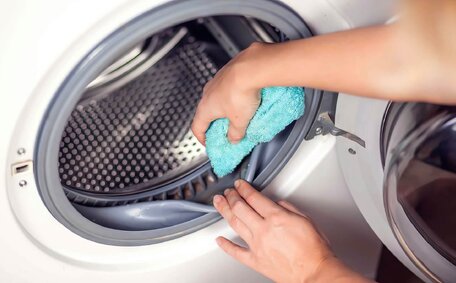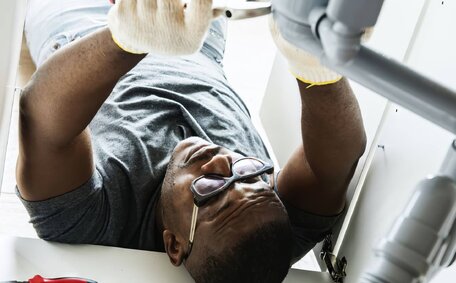Recognizing Signs of a Gas Line Leak
Recognising the following indicators can alert you to a potential gas line leak in your home:
- Sulfurous Odour - Though natural gas is odourless, an added sulfur-like scent resembling rotten eggs is a tell-tale indicator of a leak.
- Hissing or Whistling Sounds - Unusual noises such as hissing or whistling near gas lines or appliances may signal a gas escape.
- Withering Vegetation - Look for unexpected plant wilting or discolouration, which can result from gas escaping from underground lines.
- Dirt Blowing - Bubbling water or dirt blowing from a crack in the ground could indicate an underground gas leak.
- Pilot Lights Going Out - If appliance pilot lights often blow out, a leaking gas line your house hosts may be disrupting the flame.
Detecting any of these signs calls for immediate evacuation and contact with a professional gas line repair technician.
Safety Procedures for Gas Line Repairs
When performing gas line repairs, safety should be the top priority. Follow these precautions:
- Evacuate immediately and call emergency services at the first suspicion of a gas leak.
- Turn off the main gas valve to halt the flow of gas.
- Ventilate the environment by opening windows and doors before commencing any repair work to aid in dispelling gas.
- Eliminate potential ignition sources, such as cigarettes and open flames, in proximity to the gas line.
- Wear protective gear such as goggles, gloves, and a dust mask to guard against potential gas exposure.
- Carefully inspect pipes for cracks or damage.
- Use soapy water to check for smaller leaks at gas fitting junctures.
- Execute all repairs strictly according to the manufacturer’s guidelines.
- Should the need arise to repair any considerable damages, ensure a licenced gas fitter is commissioned for the task.
- For continual safety, install a gas leak detector which can alert you of leaks before future inspections.
A leaking gas line in your home can quickly become dangerous, so prioritise safety throughout the inspection and repair process. Contact professional plumbing services immediately if the leak poses risks you cannot properly address.
Tools and Materials for Repair
Addresses the necessary equipment and materials for fixing a leaking gas line, including:
- Pipe sealant or pipe thread compound - Used to create an airtight seal on pipe joints and fittings.
- Suitable Piping Material - Depending on the damage, replacement with copper, steel, or polyethylene pipes and the associated joints might be necessary.
- Pipe cutter - For cutting existing pipe to remove damaged sections.
- Sandpaper and wire brush - To clean pipes in preparation for sealant.
- Adjustable wrenches - For loosening and tightening pipes and fittings.
- Leak detection spray or solution - Bubble-forming liquid used after repairs to check for leaks.
- Multimeter - Essential for assessing the functionality of electrical components, such as igniters, that the gas leak may impact.
- Pipe wrenches - For securing pipes in place.
- Teflon tape - Used to wrap pipe threads to prevent leaks.
- Flashlight - For inspecting hard-to-reach areas of the pipe system and to ensure no issues come out after repair.
Utilise only certified equipment for gas line repairs and installations, don protective gear, and ensure the area is well-ventilated. For complicated repairs, engage a professional.
Step-by-Step Gas Line Repair
Implement these critical steps for repairing any gas line leakages:
- Diligently search for the leak’s origin using leak detection spray or bubble solution, keeping an eye out for expanding bubbles.
- Turn off any gas valves leading to the leak so only a small section of pipe needs repair.
- Cut out the damaged section of pipe using a pipe cutter.
- Replace the damaged segment with certified pipes and appropriate fittings designed for gas line installation.
- Use pipe thread compound or pipe sealant on all connections to securely repair leak.
- Conduct a pressure test, a crucial step when you perform gas repair tasks, to fix leaking joints by turning the gas back on and using leak detection spray.
- Inspect joints closely for any expanding bubbles, indicating a leak, and tighten connections as necessary.
- Reactivate the gas line, gradually restoring supply, only after confirming the absence of leaks.
- Have professionals perform regular inspections to check pipes for corrosion and potential gas issues.
Approach gas leak repairs with utmost caution; should the leak be significant or beyond personal repair capabilities, immediately summon a professional.
Calling a Professional
For repairs near a gas distributor, enlist a licenced gas fitter’s expertise. Mishandling gas leaks can be perilous, thus professional intervention with the right equipment is paramount.
Here are some key reasons you should hire a pro for gas line repairs:
- Licensing - Professionals are licenced, demonstrating their qualifications and adhering to regulations, while unlicensed DIY may be legally problematic.
- Experience - Professionals have extensive knowledge working specifically on gas systems and can accurately diagnose issues.
- Protective Gear - Gas fitters have the proper protective equipment like respirators to work safely on gas line leaks.
- Advanced Equipment - Specialised tools for detection and sealing enables gas technicians to precisely locate leaks and make quality repairs.
- Permanent Fixes - Unlike temporary DIY attempts, professionals can comprehensively repair and reinforce the gas line system.
Statistics show gas leaks cause an average of 4 explosions and 43 deaths annually in the US. Don’t take risks attempting to repair gas lines on your own - the stakes are too high. Calling a licenced professional ensures your repair job will be conducted safely while restoring the optimum function of your gas system.
Preventing Future Leaks
Regular professional inspections and maintenance are crucial to averting hazardous future gas leaks.
Conduct Annual Inspections
Annually, have a licenced plumber examine your gas lines, checking pipes, fittings, valves, and appliances for any leaks or damage, and rectifying issues promptly.
Repair or Replace Old Pipes
Severely compromised pipes may need repair or replacement; transitioning from outdated materials to modern polyethylene or PVC can enhance safety and durability.
Install Protective Coatings
Weatherproof coatings or wraps can lead to better protection for above-ground external gas lines and fittings, preventing rust and corrosion.
Update Appliances for Safety
Replace old or malfunctioning appliances such as water heaters and cookers, as they pose gas leak risks. Modern, efficient appliances contribute to a safer environment.





